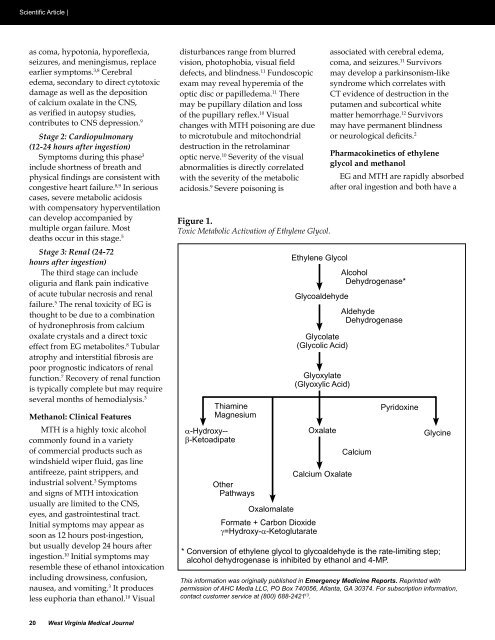September/October - West Virginia State Medical Association
September/October - West Virginia State Medical Association
September/October - West Virginia State Medical Association
You also want an ePaper? Increase the reach of your titles
YUMPU automatically turns print PDFs into web optimized ePapers that Google loves.
Scientific Article |<br />
as coma, hypotonia, hyporeflexia,<br />
seizures, and meningismus, replace<br />
earlier symptoms. 3,8 Cerebral<br />
edema, secondary to direct cytotoxic<br />
damage as well as the deposition<br />
of calcium oxalate in the CNS,<br />
as verified in autopsy studies,<br />
contributes to CNS depression. 9<br />
Stage 2: Cardiopulmonary<br />
(12-24 hours after ingestion)<br />
Symptoms during this phase 3<br />
include shortness of breath and<br />
physical findings are consistent with<br />
congestive heart failure. 8,9 In serious<br />
cases, severe metabolic acidosis<br />
with compensatory hyperventilation<br />
can develop accompanied by<br />
multiple organ failure. Most<br />
deaths occur in this stage. 5<br />
Stage 3: Renal (24-72<br />
hours after ingestion)<br />
The third stage can include<br />
oliguria and flank pain indicative<br />
of acute tubular necrosis and renal<br />
failure. 5 The renal toxicity of EG is<br />
thought to be due to a combination<br />
of hydronephrosis from calcium<br />
oxalate crystals and a direct toxic<br />
effect from EG metabolites. 8 Tubular<br />
atrophy and interstitial fibrosis are<br />
poor prognostic indicators of renal<br />
function. 7 Recovery of renal function<br />
is typically complete but may require<br />
several months of hemodialysis. 3<br />
Methanol: Clinical Features<br />
MTH is a highly toxic alcohol<br />
commonly found in a variety<br />
of commercial products such as<br />
windshield wiper fluid, gas line<br />
antifreeze, paint strippers, and<br />
industrial solvent. 3 Symptoms<br />
and signs of MTH intoxication<br />
usually are limited to the CNS,<br />
eyes, and gastrointestinal tract.<br />
Initial symptoms may appear as<br />
soon as 12 hours post-ingestion,<br />
but usually develop 24 hours after<br />
ingestion. 10 Initial symptoms may<br />
resemble these of ethanol intoxication<br />
including drowsiness, confusion,<br />
nausea, and vomiting. 3 It produces<br />
less euphoria than ethanol. 10 Visual<br />
disturbances range from blurred<br />
vision, photophobia, visual field<br />
defects, and blindness. 11 Fundoscopic<br />
exam may reveal hyperemia of the<br />
optic disc or papilledema. 11 There<br />
may be pupillary dilation and loss<br />
of the pupillary reflex. 10 Visual<br />
changes with MTH poisoning are due<br />
to microtubule and mitochondrial<br />
destruction in the retrolaminar<br />
optic nerve. 10 Severity of the visual<br />
abnormalities is directly correlated<br />
with the severity of the metabolic<br />
acidosis. 9 Severe poisoning is<br />
Figure 1.<br />
Toxic Metabolic Activation of Ethylene Glycol.<br />
Thiamine<br />
Magnesium<br />
a-Hydroxy--<br />
β-Ketoadipate<br />
Other<br />
Pathways<br />
Oxalomalate<br />
Formate + Carbon Dioxide<br />
γ=Hydroxy-a-Ketoglutarate<br />
Ethylene Glycol<br />
Glycoaldehyde<br />
Glycolate<br />
(Glycolic Acid)<br />
Glyoxylate<br />
(Glyoxylic Acid)<br />
Oxalate<br />
Calcium Oxalate<br />
associated with cerebral edema,<br />
coma, and seizures. 11 Survivors<br />
may develop a parkinsonism-like<br />
syndrome which correlates with<br />
CT evidence of destruction in the<br />
putamen and subcortical white<br />
matter hemorrhage. 12 Survivors<br />
may have permanent blindness<br />
or neurological deficits. 2<br />
Pharmacokinetics of ethylene<br />
glycol and methanol<br />
EG and MTH are rapidly absorbed<br />
after oral ingestion and both have a<br />
Alcohol<br />
Dehydrogenase*<br />
Aldehyde<br />
Dehydrogenase<br />
Calcium<br />
Pyridoxine<br />
Glycine<br />
* Conversion of ethylene glycol to glycoaldehyde is the rate-limiting step;<br />
alcohol dehydrogenase is inhibited by ethanol and 4-MP.<br />
This information was originally published in Emergency Medicine Reports. Reprinted with<br />
permission of AHC Media LLC, PO Box 740056, Atlanta, GA 30374. For subscription information,<br />
contact customer service at (800) 688-2421 13 .<br />
20 <strong>West</strong> <strong>Virginia</strong> <strong>Medical</strong> Journal















